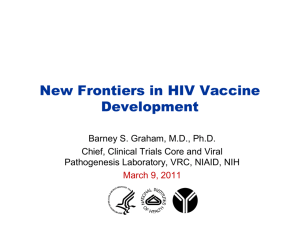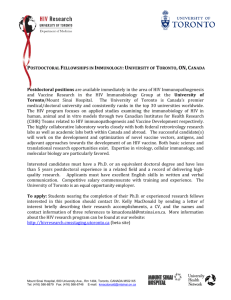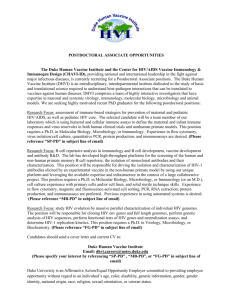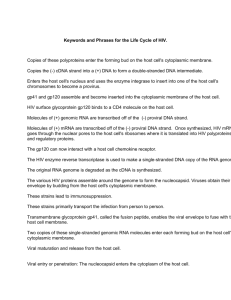Orientation to the HVTN Meeting
advertisement
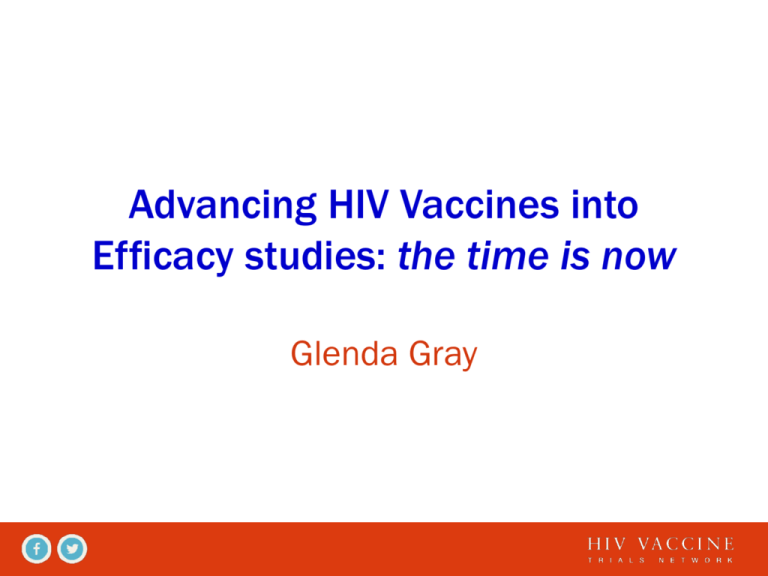
Advancing HIV Vaccines into Efficacy studies: the time is now Glenda Gray What we need to end AIDS: controlling viremia New classes of Drugs Point of care viral load & CD4 monitoring FDCs, long acting ARVS & child friendly formulations Innovations in the management of HIV that will impact on community viral load and infectiousness: prevention of secondary transmission HIV Vaccines & other immune based strategies Immunological & Drug Based Strategies aimed at the latent reservoir Microbicide development & long acting ARVS for PrEP Innovations in Prevention that will be required when secondary transmission is not averted HIV Cure: to enable control by eliminating viremia in those infected Transmission occurs sub-clinically Gray, G et al Plos Biol, in press 2015 “Ultimately, we believe, the only guarantee of a sustained end of the AIDS pandemic lies in a combination of non-vaccine prevention methods and the development and deployment of a safe and effective HIV vaccine.” Challenges for making HIV vaccines • Scientific: highly variable virus that integrates into host genome, rapidly establishing latency, evading both humoral & cellular responses Limited financial Investment from Private Sector & LMIC countries Limited pharmaceutical support HIV PREVENTION R&D BY FUNDER TYPE 2013 US Public Sector Other Governments European Public Sector Philanthropic Industry 3% 15% 6% 5% 71% Donaldson E, et al, HIVR4P 2014 This has resulted in only 4 vaccine concepts that have been tested in 6 efficacy trials in 30 years 6 Clinical HIV-1 Vaccine Efficacy Trials (Barouch & Michael, 2013) Study/ location Vaccine/s Risk Group/HIV incidence Result 1. Vax003 Thailand AIDSVAX B/E gp120 in alum IDUs 3.4% No VE 1. Vax004 US/Europe AIDSVAX B/B gp120 in alum MSM/high risk women 2.6% No VE 2. HVTN 502 Americas STEP MRKAd5 HIV-1 gag/pol/nef MSM/high risk women 3% Halted for futility; early transient increased infection in vaccinees 2. HVTN 503 RSA Phambili MRKAd5 HIV-1 gag/pol/nef Heterosexual men & women 3.7% No VE; late increased HIV infection in unblinded male vaccinees 3. RV144 Thailand ALVAC-HIV vCP1521, Heterosexual men AIDSVAX B/E rgp120 in and women with alum variable risk 0.28% 31.2% VE @ 42/12; DNA(gag/pol/nef/env) rAD5gag/pol/env (A,B,C) Halted at interim analysis for futility 4. HVTN 505 Circumcised MSM Ad5 7neg 1.8% 60% VE @ 12/12 Thai Trial (RV144) Primary Results Modified Intention-to-Treat Analysis* 1.0 0.9 Probability of HIV Infection (%) 0.8 Placebo 0.7 0.6 Vaccine 0.5 0.4 0.3 0.2 0.1 0.0 0.0 0.5 1.0 1.5 2.0 Years 2.5 3.0 3.5 125 HIV infections in 16395 subjects Kinetics of Vaccine-Induced Immune Response and Vaccine Protection Based on RV144 Limited/No Vaccine Protection Good Vaccine Protection Waning Vaccine Protection Levels T-cells Poor Ab Response, T-cells Ab 0 1 3 6 Pox Pox Pox + Env protein Pox + Env protein Months 9 AIDS Vaccine Conference 2009, Bangkok 12 Pox + Env protein Key correlates that emerged from RV144 that appeared to be related to Vaccine Efficacy (Haynes, 2012) The binding of plasma IgA to env The avidity of IgG antibodies for env Antibody Dependent Cellular Cytotoxicity (ADCC) VE VE The binding of IgG antibodies to the V1V2 region of gp 120 Neutralising Antibodies to vaccine antigen The magnitude of CD4 T cells specific for HIV-1 env In vaccinees with low plasma IgA responses Association between V1V2 antibodies and HIV acquisition in RV144 is critical to VE A 10000 B Probability of Infection 0.010 MFI 1000 100 10 Placebo Low Medium High 0.008 0.006 0.004 0.002 0.000 0 0 Uninfected Low Medium High Placebo Uninfected Vaccine 12 24 Time since Week 26 visit (months) 36 V1/V2 IgG Correlate of Risk • V2 Specific mAbs were isolated and characterized that involve position 169 in the V2 loop (Liao et al. Immunity 2013). • Virus sieve analysis in the V2 loop at position 169 (Rolland et al. Nature 2012). V2 Loop Crown 181 169 α4β7 binding motif • 60% of clade C isolates have lysine at position 169 vs 10% of clade B isolates Flanks lack of a direct correlation between neutralising antibodies and HIV-1 acquisition Even at peak antibody response, none of the sera from the vaccinees neutralised a panel of 20 contemporaneous isolates of HIV-1 circulating in Thailand during the course of the trial….. Post RV144 world: conceptual summary of the correlates work • Non neutralising antibodies with antibody functions such as ADCC, ADCP & virion capture, as well as polyfunctional CD4 T cell responses were associated with VE • Neutralisation was not the mechanism that protected against HIV acquisition • Strategies that build on these concepts have formed the basis of the efficacy studies taken forward Besides non neutralising HIV vaccine approaches….other things were happening in the neutralising space Immunogen design to induce neutralisation • Advances in B cell technology have enabled the field to identify and isolate broadly neutralising antibodies from persons with chronic HIV infection • Passive transfer of these BNABS have demonstrated protection in NHPs from experimental challenge • Opening up a new vaccine approach either utilising these BNABS as passive immunisation or to form the basis of new immunogen design Efficacy Studies This leads us to evaluate 3 strategies to advance HIV immunization P5 “Clade C” approach using ALVAC & gp120/MF59 (HVTN 702) Multi-clade approach using rAd26/MVA/gp140 trimer Neutralising antibody approaches 2010 Formation of the P5 Partnership Purpose: To build on RV144 data and ultimately license a poxprotein based HIV vaccine with the potential for broad and timely public health impact. Strategy: Continue to build public-private partnerships critical for success. 1. Work with host countries to support a flexible regulatory strategy in target populations and regions. 2. Generate and incorporate knowledge from the assessment of nextgeneration vaccine concepts. The Strategy for the ALVAC/Protein Phase 3 Program Construction of ALVAC-HIV-C (vCP2438) Construction of Bivalent Subtype C gp120/MF59 Optimize regimen by increasing potency and durability Booster at 12 months HVTN Strategy for the Phase 3 Program HVTN 097 HVTN 100 HVTN 702 Designed to evaluate RV144 vaccine regimen in RSA and compare immunogenicity to that in Thailand A standard phase 1 trial of the clade C products to decide whether to proceed to phase 3 A Classic phase 3 RCT assessing efficacy and safety aimed at licensure Peak CD4+ T Cell Response Rates and Magnitudes are Higher in Prevalence in 097 vs. RV144 Response rate: 50.3% 88/175 RV144 69.2% 54/78 HVTN 097 92TH023-ENV 2.5% 1/40 RV144 3.8% 3/78 HVTN 097 LAI-GAG Gray G HIVR4P, 2014 Comparison of V1V2 IgG responses between 097 and RV144 Gray G HIVR4P, 2014 Study Schema: HVTN 100 N (total 252) Primary Vaccine Regimen Booster Month 0 Month 1 Month 3 Month 6 Month 12 210 ALVAC-HIV (vCP2438) ALVAC-HIV (vCP2438) ALVAC-HIV+ Bivalent Subtype C gp120/MF59® ALVAC-HIV+ Bivalent Subtype C gp120/MF59® ALVAC-HIV+ Bivalent Subtype C gp120/MF59® 42 Placebo Placebo Placebo + Placebo Placebo + Placebo Placebo + Placebo Products: • ALVAC-HIV (vCP2438) expressing HIV-1 env (clade C gp120), clade B (gp41), gag (clade B) & protease (clade B) (Dose: >1 X 106 CCID50) • Bivalent subtype C gp120/MF59 containing 100mcg TV1.Cgp120 & 100mcg 1086.Cgp120 Immunogenicity evaluation to be applied to this study to inform advancement into phase 3: study fully enrolled in RSA Go/No-Go Criteria: HVTN 100 Must Meet all of the Following Conditions to advance to HVTN 702 Parameters to be assessed Prevalence of Binding Antibodies to clade C gp120 antigens in the vaccine that approach 90% Prevalence of V1V2 antibodies to clade C gp70 scaffold antigens of >57% at week 28 CD4+ T cell responses to HIV env of ~60% The above immune responses would, based upon RV 144 predict a VE=50% @ 2 years Study Schema: HVTN 702 N (total 5400) Primary Vaccine Regimen Booster Month 0 Month 1 Month 3 Month 6 Month 12 2700 ALVAC-HIV (vCP2438) ALVAC-HIV (vCP2438) ALVAC-HIV+ Bivalent Subtype C gp120/MF59® ALVAC-HIV+ Bivalent Subtype C gp120/MF59® ALVAC-HIV+ Bivalent Subtype C gp120/MF59® 2700 Placebo Placebo Placebo + Placebo Placebo + Placebo Placebo + Placebo Estimated Total Study duration 72 months: • Stage 1: 60 months-18 months for enrolment, 24 months of follow-up for HIV-1 uninfected individuals, 18 months follow up for HIV-1 infected individuals) • Stage 2: an additional 12 months of follow up for uninfected individuals Efficacy Studies 3 strategies to advance immunization P5 “Clade C” approach using ALVAC & gp120/MF59 (HVTN 702) Multi-clade approach using rAd26/MVA/gp140 trimer Neutralising antibody approaches HIV vaccine research program: Janssen and Collaborators BIDMC Harvard IAVI Ragon MHRP NIAID/HVTN HIV Vaccine Aiming at Protection Against all Clades of HIV-1 Different HIV-1 clades dominate in different geographic regions Adolescents (11-17 years) /Adults (18-65 years) in endemic countries and populations at risk in Western world 1 2 3 Potent priming Vectors Mosaic inserts for global coverage Trimeric env protein for improved humoral immunity Low seroprevalent Ad26 Ad26.HIV-Gag-Pol Ad26.HIV-Env (MVA.HIV-Gag-Pol-Env) Dan H Barouch et al, 2013 Dan H Barouch et al., 2010 29 A prime-boost vaccine regimen aiming at global coverage starting 2017-2021 Boost Prime Ad26 Mosaic vectors gag-pol-env Ad26 Mosaic vectors gag-pol-env 0 +/- or Ad26 Mosaic vectors gag-pol-env months Soluble trimer gp140 env protein MVA Mosaic vectors gag-pol-env 3 Soluble trimer gp140 env protein +/- 6 Regimen to be selected after Phase 1/2a 12 Ad26/Env SIV Vaccines Partially Protect Against IR SIVmac251 Challenges in Rhesus Monkeys 90% reduction of per exposure acquisition risk for Ad/Env (P=0.001) 50% (6 of 12) show complete protection for Ad/Env (P=0.01) • 32 rhesus monkeys • • • Ad26/Env (N=12) Ad26/Ad35 (N=12) Sham (N=7) • Repetitive, intrarectal, heterologous SIVmac251 challenges • Correlates of protection • • • ELISA Ab Funct NAb P < 0.0001 P = 0.004 P = NS Barouch et al. Science 2015 Efficacy Studies 3 strategies to advance immunization P5 “Clade C” approach using ALVAC & gp120/MF59 (HVTN 702) Multi-clade approach using rAd26/MVA/gp140 trimer Neutralising antibody approaches Neutralising Ab to HIV-1 V3-glycan V1V2-glycan CD4 binding site gp41 MPER gp120/41 interface o V1V2-Glycan – bind to trimer cap o V3-glycan, N332 supersite o gp41 MPER – near mebrante o gp120/41 interface – bind to parts of both gp120 and gp41 o CD4 binding site of gp120 – where the virus attaches to CD4 Only antibodies that have advanced to the clinic (VRC01, 3BNC117) Christina Corbaci, Andrew Ward, Use of HIV Antibodies in Prevention Can mAb prevent infection in high risk adults (Antibody Mediated Prevention) Can mAb protect infants during childbirth and breastfeeding Can we use it as a topical microbicide? What level of antibody is needed (ug/ml) to protect How long will the antibody work (weeks, months?) Cocktails to increase breadth vs potency All the NHP studies are with cell free virus, in humans we know that there is cell associated sexual and breast milk HIV transmission 35 Neutralising Ab to HIV-1 V3-glycan V1V2-glycan CD4 binding site gp41 MPER o V1V2-Glycan – bind to trimer cap o CD4 binding site of gp120 – where the virus attaches to CD4 gp120/41 interface Only antibodies that have advanced to the clinic (VRC01, 3BNC117) Christina Corbaci, Andrew Ward, Neutralisation Activity of VRC01 Virus clade Number of viruses IC50 < 50 µg/mL IC50 < 1 µg/mL A 22 100% 95% B 49 96% 80% C 38 87% 66% D 8 88% 50% CrRF01_AE 18 89% 61% CRF02_AG 16 81% 56% G 10 90% 90% CRF07_BC 11 100% 45% Other 18 83% 78% Total 190 91% 72% 37 VRC01 Protects against Mucosal SHIV-Challenge in Non-human Primates 20 mg/kg infusion of VRC01: Challenge with SHIV SF162P3 VAGINAL CHALLENGE RECTAL CHALLENGE 4/4 protected 4/4 protected 80 VRC01 Control 60 40 0/4 protected 20 0 0 5 10 15 20 25 Days post challenge • Pegu et al. Science Transl Med (2014) • Ko et al. Nature (2014) • Rudicell et al. J Virol (2014) 30 P e rc e nt uninf e c te d Percent uninfected 100 100 VR C 01 80 C ontrol 60 40 20 0 1/4 protected 0 5 10 15 20 D a ys post cha llenge 25 30 Passive Antibody Prevention NHP studies tell us that physiologically achievable levels of Ab could prevent HIV-1 infection: But no direct proof in humans Need to Learn from Proof of Concept in Humans and understand the mechanism in which bNABs protect against infection Antibody Mediated Prevention trial (HVTN/HPTN) in MSM (clade B) & heterosexual women (clade C) starting in 2016 Preventing HIV infection in women by passive immunisation with CAP256-VRC26.25 SA team identified a potent V1V2 BNab in patient- CAPRISA 256 Y • From an acute infection cohort where approximately 7 participants developed antibody responses able to neutralize >40% of circulating viruses Breadth and potency of CAP256-VRC26.25 and other selected bNAbs against HIV-1 clade C isolates Increasing potency 0.00001 IC50 (ug/ml) 0.0001 0.001 0.01 0.1 1 10 100 CAP256.08 CAP256.25 PGDM1400 PG9 CH01 PGT121 PGT151 VRC01 10E8 Data show IC50 neutralization titers of a clade C virus panel (n=54) assessed by TZM-bl pseudovirus assay. Each dot shows the value for a single virus. Bars indicate median value of viruses that are neutralized. Nicole Doria-Rose, John Mascola, VRC Log RNA Copies/ml Log RNA Copies/ml Prophylactic efficacy of CAP256.VRC26.25.LS against high-dose IR SHIV-325C challenge in Rhesus monkeys 2 mg/kg 0.08 mg/kg 0.4 mg/kg Sham Days Following Challenge Source: Dan Barouch The critical link between AMP & immunogen design will be in defining the levels of neutralisation required to achieve protection and will set the standard for developing immunogens that achieve these levels of antibodies 44 Develop highly effective strategies to reduce HIV acquisition e.g HIV vaccine, or novel ways to administer broadly reactive neutralizing antibodies Develop long acting pre exposure prophylaxis strategies that can be used topically or systemically for both men & women Deliver ARV Treatment "en masse" including implementing highly effective programs to eliminate mother to child transmission What we need to remember Acknowledgements • IAS Ken Mayer • HVTN Larry Corey • VRC John Mascola Barney Graham & Funders: NIAID/BMGF/SAMRC • J&J/Janssen Dan Barouch Nelson Michael • Frank Tomaka • CAPRISA/NICD Salim Abdool Karim Lynn Morris Penny Moore Quarraisha Abdool Karim
